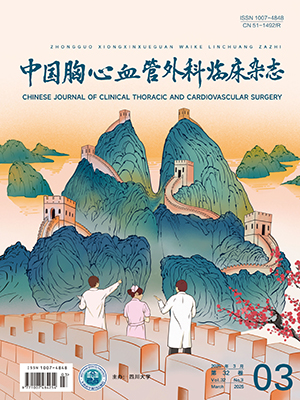| 1. |
Torre LA, Bray F, Siegel RL, et al. Global cancer statistics, 2012. CA Cancer J Clin, 2015, 65(2): 87-108.
|
| 2. |
Yang X, Wang S, Qu J. Video-assisted thoracic surgery (VATS) compares favorably with thoracotomy for the treatment of lung cancer: A five-year outcome comparison. World J Surg, 2009, 33(9): 1857-1861.
|
| 3. |
Dela Cruz CS, Tanoue LT, Matthay RA. Lung cancer: Epidemiology, etiology, and prevention. Clin Chest Med, 2011, 32(4): 605-644.
|
| 4. |
Kutlu CA, Williams EA, Evans TW, et al. Acute lung injury and acute respiratory distress syndrome after pulmonary resection. Ann Thorac Surg, 2000, 69(2): 376-380.
|
| 5. |
Miller JI. Physiologic evaluation of pulmonary function in the candidate for lung resection. J Thorac Cardiovasc Surg, 1993, 105(2): 347-351.
|
| 6. |
Beckles MA, Spiro SG, Colice GL, et al. The physiologic evaluation of patients with lung cancer being considered for resectional surgery. Chest, 2003, 123(1 Suppl): 105S-114S.
|
| 7. |
Yoshimi K, Oh S, Suzuki K, et al. Impact of airflow limitation on comorbidities and postoperative complications in patients undergoing thoracic surgery: A retrospective observational study. Ann Thorac Cardiovasc Surg, 2016, 22(3): 146-152.
|
| 8. |
Keddissi JI, Kinasewitz GT. The more, the better: Maximum oxygen uptake and lung resection. Chest, 2005, 127(4): 1092-1094.
|
| 9. |
Ferguson MK, Vigneswaran WT. Diffusing capacity predicts morbidity after lung resection in patients without obstructive lung disease. Ann Thorac Surg, 2008, 85(4): 1158-1164.
|
| 10. |
Markos J, Mullan BP, Hillman DR, et al. Preoperative assessment as a predictor of mortality and morbidity after lung resection. Am Rev Respir Dis, 1989, 139(4): 902-910.
|
| 11. |
Sawabata N, Nagayasu T, Kadota Y, et al. Risk assessment of lung resection for lung cancer according to pulmonary function: Republication of systematic review and proposals by guideline committee of the Japanese Association for Chest Surgery 2014. Gen Thorac Cardiovasc Surg, 2015, 63(1): 14-21.
|
| 12. |
de Torres JP, Marín JM, Casanova C, et al. Lung cancer in patients with chronic obstructive pulmonary disease—Incidence and predicting factors. Am J Respir Crit Care Med, 2011, 184(8): 913-919.
|
| 13. |
McAlister FA, Khan NA, Straus SE, et al. Accuracy of the preoperative assessment in predicting pulmonary risk after nonthoracic surgery. Am J Respir Crit Care Med, 2003, 167(5): 741-744.
|
| 14. |
Campos JH, Feider A. Hypoxia during one-lung ventilation—A review and update. J Cardiothorac Vasc Anesth, 2018, 32(5): 2330-2338.
|
| 15. |
Gould G, Pearce A. Assessment of suitability for lung resection. Contin Educ Anaesth Crit Care Pain, 2006, 6(3): 97-100.
|
| 16. |
Fernandes EO, Teixeira C, Silva LC. Thoracic surgery: Risk factors for postoperative complications of lung resection. Rev Assoc Med Bras (1992), 2011, 57(3): 292-298.
|
| 17. |
Mizuguchi, Shinjiro, Takashi I, et al. Arterial blood gases predict long-term prognosis in stageⅠ non-small cell lung cancer patients. BMC Surgery, 2016, 16(3): 3.
|
| 18. |
徐城, 崔珊珊, 夏中元. 纤维支气管镜使用后单肺手术期间低氧血症的多因素分析. 分子影像学杂志, 2020, 43(3): 516-519.
|
| 19. |
Beaumont M, Losq A, Péran L, et al. Comparison of 3-minute step test (3MStepT) and 6-minute walk test (6MWT) in patients with COPD. COPD, 2019, 16(3-4): 266-271.
|
| 20. |
Brunelli A, Kim AW, Berger KI, et al. Physiologic evaluation of the patient with lung cancer being considered for resectional surgery: Diagnosis and management of lung cancer, 3rd ed: American College of Chest Physicians evidence-based clinical practice guidelines. Chest, 2013, 143(5 Suppl): e166S-e190S.
|
| 21. |
殷欣, 许智博, 钱福勇, 等. 公式计算的心肺适能(CRF)和6分钟步行距离(6MWD)预测上腹部大手术术后肺部并发症(PPCs)的效能比较. 复旦学报(医学版), 2020, 47(3): 320-326.
|
| 22. |
Marjanski T, Wnuk D, Bosakowski D, et al. Patients who do not reach a distance of 500 m during the 6-min walk test have an increased risk of postoperative complications and prolonged hospital stay after lobectomy. Eur J Cardiothorac Surg, 2015, 47(5): e213-e219.
|
| 23. |
Agarwala P, Salzman SH. Six-minute walk test: Clinical role, technique, coding, and reimbursement. Chest, 2020, 157(3): 603-611.
|
| 24. |
Balady GJ, Arena R, Sietsema K, et al. Clinician's guide to cardiopulmonary exercise testing in adults: A scientific statement from the American Heart Association. Circulation, 2010, 122(2): 191-225.
|
| 25. |
姜格宁, 张雷, 朱余明, 等. 肺切除手术患者术前肺功能评估肺科共识. 中国胸心血管外科临床杂志, 2020, 27(1): 1-9.
|
| 26. |
Brunelli A, Belardinelli R, Refai M, et al. Peak oxygen consumption during cardiopulmonary exercise test improves risk stratification in candidates to major lung resection. Chest, 2009, 135(5): 1260-1267.
|
| 27. |
Oga T, Nishimura K, Tsukino M, et al. Analysis of the factors related to mortality in chronic obstructive pulmonary disease: Role of exercise capacity and health status. Am J Respir Crit Care Med, 2003, 167(4): 544-549.
|
| 28. |
Baba R, Nagashima M, Goto M, et al. Oxygen uptake efficiency slope: A new index of cardiorespiratory functional reserve derived from the relation between oxygen uptake and minute ventilation during incremental exercise. J Am Coll Cardiol, 1996, 28(6): 1567-1572.
|
| 29. |
王俊义, 张鹏, 刘毅梅, 等. 6分钟步行试验与运动心肺功能测定预测肺癌患者术后并发症的价值. 天津医科大学学报, 2013, 19(2): 137-139.
|
| 30. |
Ninan M, Sommers KE, Landreneau RJ, et al. Standardized exercise oximetry predicts postpneumonectomy outcome. Ann Thorac Surg, 1997, 64(2): 328-332.
|




